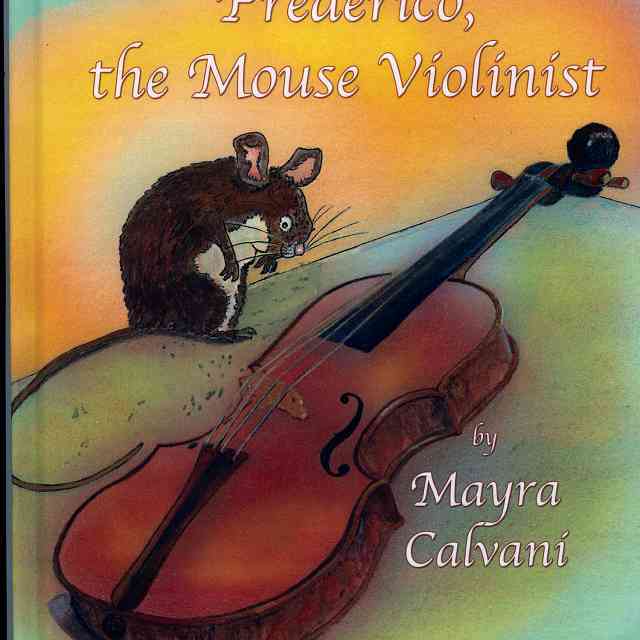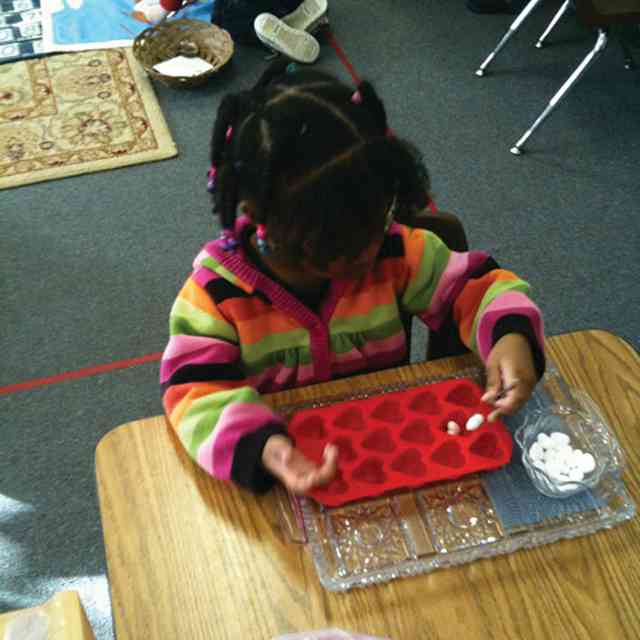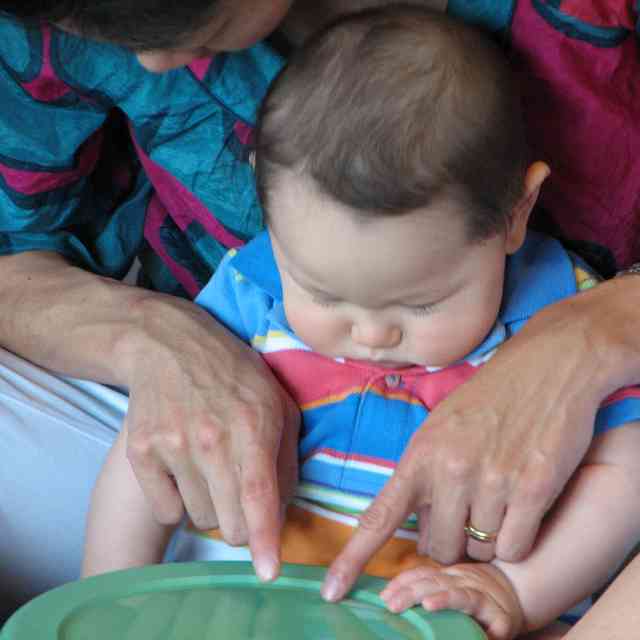I grew up as a traditional viola student and was very fortunate to have an excellent, world-class teacher from the time I was ten until I left for college at seventeen.
I remember sitting outside her door, waiting for my first lesson while she practiced, and hearing this huge, warm, rich tone. It was like nothing I had ever heard. In my mind I expected a giant to come out of the room, and then, when the door opened, there was a very petite, soft-spoken, and gentle young woman to usher me in for my lesson. Each lesson, she would play whatever piece I happened to be working on, and I would hear an enormously beautiful tone and witness an excellent demonstration of technique. Then it was my job to go home, practice, and try to duplicate what I had heard. All week I would practice diligently with the intention of playing it every bit as good as she did. That demonstration would have to play in my head over and over until I saw her again. Sometimes I remembered correctly, sometimes not. It probably wasn’t until my later teens that I might get a recording of what I was working on, if I could find it, listen to it a few times, and then put it on a shelf.
The key element that I know will help you and your child feel and achieve more success on your Suzuki journey is listening. Ed Kreitman states in his book Teaching from the Balance Point: “One of the most important ingredients in the Suzuki method is the concept of listening.” That is a powerful statement and yet so simple. The Suzuki Method was relatively new when I was a child. I was a traditional student, so I always heard the myths about Suzuki: Suzuki students only played by ear, never learned to read music, and couldn’t play musically. What I discovered as a Suzuki teacher is that the advantage of children in a Suzuki program is huge. Not only do they get to hear what they are working on in person every week, they can play it on the CD player whenever they want, and they get to play it in group class with other children too.
We must strive to create a musical environment that immerses children in music, just as when they are babies and parents speak to them for hours, repeating the same words over and over until they start speaking. If not for parents’ efforts and endless repetitions, children would not develop the vocabulary they are capable of knowing. From birth and even before, children constantly hear people conversing—a real symphony of sounds they are able to pick up and use. Some are words or sounds they won’t use for many years, yet they still hear them. Building an environment like that with music is what Dr. Suzuki intended for us to do. Playing the CD of the book they are working on is good passive listening. It is good for them to hear the songs they may have already learned and the songs they will learn. Surround them with music from the time they wake until they go to bed. Repetition is key; however, just playing the CD over and over from beginning to end is not really enough.
Kay Slone, a well-respected and successful Suzuki teacher trainer, clinician, and author, gave this suggested listening plan in They’re Rarely Too Young and Never Too Old To Twinkle:
- Current Listening: The piece that is presently being studied is recorded 20-50 times consecutively.
- Review Listening: The pieces which are being polished should be taped 10-20 times consecutively.
- Preview Listening: The piece which will be studied next should be taped 20-50 times.
Does this seem a bit over the top? It will produce results. As Dr. Suzuki stated, “your child will progress in direct relation to the amount of listening he/she does.” One clip in the movie Nurtured by Love sticks out in my mind. It shows a young Japanese boy playing outside with a tape player strapped to his back. That is dedication to listening. Today, we have many easier ways to provide a good listening environment. If you child has an iPod, life just got better for you, and if not, it might be time to get one.
My wife grew up as a Suzuki violin student and is now a Suzuki violin teacher. Recently, she shared with me the memory of listening to Handel Bourree while reading Little House on the Prairie. Her mother religiously recorded endless tapes with her current song and the upcoming songs she would be learning. These were the days before CDs, MP3s, and iPods, so a tape that would play in an endless loop was the best thing available. There was always some sort of music playing in the house. To this day, my mother-in-law has music playing in the house at all times. She created a listening environment that went beyond the bounds of the Suzuki repertoire, probably for her own sanity, but nonetheless, she put forth the effort and made it happen.
If you play the Suzuki Violin Book One CD straight through continuously, you will hear the entire thing approximately two times per hour. Hearing the Book One CD roughly twice an hour for an entire day may cause you to have unkind thoughts. So, make a plan to help break the monotony. Expand everyday listening to include a variety of classical music that your child will someday be playing and build a library they can refer to later on in their journey. Ask your teacher for ideas and favorites. I was fortunate that my teacher was a member of the Blair String Quartet, so I grew up with chamber music all around me; I had many opportunities to hear great music. Take your children to concerts of all kinds, and let them witness people performing at a high level of accomplishment and ability. Let them talk to the performers and ask questions, if possible. It will be an educational experience and could really make a difference in their perspective and help create a new reality. If nothing else, as Kreitman suggests in Teaching From the Balance Point, listen to the recording a few books beyond where your child is right now. This can be inspiring for them to know that they will be playing those pieces eventually. Help them look far in the future at the big picture, not just at their next piece. Learn to enjoy the process, not just the product.
In his book Helping Parents Practice, Edmund Sprunger says, “If your child starts complaining about being sick of the recording, by all means let your child be sick of the recording—at the same time that you continue to play it. I know of no incidences in which children were damaged by hearing the recording too much—it doesn’t even create the slightest puncture wound.”
So far, we have addressed passive listening: creating an environment that allows the student to simply absorb the sound. Active listening is when your child is engaged with the music. All children benefit from active listening. Have them listen for a certain note, a bow circle, staccato or legato articulation, notes going up the scale, or notes going down the scale, and assign them a physical cue when they hear it. Singing, marching to the beat, or even dancing to the music will help them be aware of many things that may go unnoticed when passively listening. When they are actively listening, they must sense the music and interpret, evaluate, and respond to the sounds they hear. Make a game of it. Children love to learn when there is joy involved.
Often, a parent’s biggest concern is, “How do I get my child to be motivated and practice?” The answer is, help them achieve a feeling of mastery by creating an environment in which they will learn more easily. Hearing sounds they will make with their instrument creates a familiar inner vocabulary that doesn’t feel like a foreign language. I’m sure we have all been to a foreign country where we didn’t speak the language—it is a real struggle to communicate. Imagine trying to play an instrument or communicate with those around you when you aren’t familiar with the sounds. Think of how difficult it would be.
All parents want the best for their child. If we put forth the effort, like that little boy’s mother did by strapping a tape player to his back while he played outside, we can help them feel good about their growing ability. This feeling is the best way to motivate your child. Seeing what a difference consistent listening will make in your child’s progress will motivate both of you. Watch ability grow. “Ability breeds ability,” Dr. Suzuki said. Find the discipline to make and play that special CD and make listening a priority. Lead the children by example and soon they will know that listening is just something they must do, like homework or brushing their teeth. This listening portion of your job at home is probably the easiest thing you can do to help your child gain a musical vocabulary, but it is also the easiest to disregard. Playing the CD while your child is doing homework, reading a book, or playing is a great habit to start. Making that “special” CD or loading their iPod with a playlist of their review, current, and upcoming songs would only take few minutes of your time and propel them into a new world. When you start to see the results, suddenly, Kay Slone’s listening plan won’t seem so far-fetched.
Practice—I Mean, Homework
Recently, I had a student come to yet another lesson unprepared. I stopped her and asked if there was anything new in her life or if anything unusual happened lately. Puzzled, she stopped, thought, and said “No, nothing new.” I asked if she thought the piece she was playing had improved since the last time I saw her. She said she didn’t have time to practice much and she just couldn’t get it. I asked if she had understood the assignment, and she said yes. I then asked, “What would happen if you went to school and handed in your homework and told the teacher you didn’t have time and just couldn’t get it?” She said, “But that’s homework.” I asked her, “Is there a difference between the assignment I gave you and the assignment you got from your teacher at school?” She had never thought of practicing as homework. For a music teacher, practice is homework. I looked up the definition of practice in the dictionary, and here is what I found:
Practice:
- To perform or work at repeatedly so as to become proficient;
- To train by repeated exercises;
- To do repeated exercises for proficiency.
Kids have so many activities for which they practice once or twice a week and in some cases, several times a week—soccer, hockey, baseball, football, basketball, lacrosse, swimming, tennis, school plays, and so on. The coach requires them to practice if they want to play in the game. In this case, practice doesn’t happen at home, only when they see the coach. It doesn’t work that way with an instrument. They need the instrument in their hands on a daily basis. Practice can’t wait until you see the “coach” again. The more familiar they are with their instrument and how it works, the more easily they figure out how to create the sounds they have heard so many times. Lessons will be easier for the teacher to teach, easier for the student to absorb and produce what the teacher is asking, and more relaxing for you.
Create an environment that immerses your child in the sounds with which they need to be familiar. Listen constantly, both passively and actively. Expand their listening beyond their Suzuki CDs and expose them to as many live performances as you can. Do your homework every day. Review old pieces and raise ability with a piece they already know. Your teachers have put a lot of time, money, and effort into training. Listen to them, trust them, support them and work together with them to learn what helps your child most.
In the wise words of Michele Higa George, “If they are playing it more times per day than they are hearing it on the CD, they think the way they are playing it is the way it goes!” I hope that if you haven’t already, you will make listening a priority and enjoy the results of life on the fast track.










